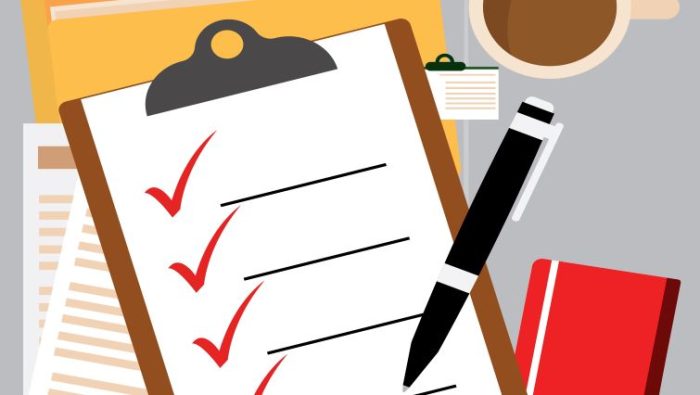Your New Go-To Employee Offboarding Checklist
 Publié le 27 July 2022
Publié le 27 July 2022
When an employee decides to leave your organization, use your new go-to employee offboarding checklist to make the transition as smooth and effective as possible.
Employees are the most important part of any company, but not all will remain in the organization forever. It is only natural that every company will experience employee turnover. In fact, an annual employee turnover rate of 18% is considered average for most businesses.
When the resignation letter reaches your desk, as an HR Manager you are responsible for ensuring a smooth transition. But what happens once you receive that resignation letter? It is time to follow a proper offboarding process for the employee.
To help you facilitate a smooth employee exit, we have put together your new go-to employee offboarding checklist in order to make an effective process for employers and employees alike. Read on to find out the exact steps you need to follow when an employee leaves your company.
Your New Go-To Employee Offboarding Checklist
- Tell your immediate team
- Have a knowledge transfer plan
- Update the company directory with relevant details
- Prepare a checklist for asset handover
- Sort the HR documentation
- Do the exit interview and ask for feedback
- Remove system access
- Settle the final pay
1. Tell your immediate team
Once an employee has sent you their resignation letter, they are on their notice period. While you prepare for their upcoming departure, it is essential to let the rest of your team know right away.
Every business establishes specific SMART business goals to manage its business operations more efficiently. One of the primary goals is effective communication across all departments. As a human resource professional, timely dissemination of information is one of your primary responsibilities.
Therefore, the quicker you inform the larger workplace about an employee’s imminent departure, the better. It helps keep unnecessary rumors and gossip at bay, which can be bad for trust and morale, and you can establish a straightforward narrative of the employee exit.
When you are circulating this information, you should include the following:
- Brief reasoning for the employee exit
- Note of gratitude to thank them for their service to the company
- Information about their replacement (if known)
Those are some of the essential pointers that need to be communicated to others. If the employee is a senior executive, you could even organize a more public announcement befitting their seniority.
2. Have a Knowledge Transfer plan
One of the reasons long-term employees are very valuable to the company is their vast knowledge of the business and its procedures and inner workings. They acquire valuable information about the company’s workings during the entire employee lifecycle, developed through hard work and trial and error over time.
Therefore, an essential step on your new go-to employee offboarding checklist is to initiate a knowledge transfer process. Whenever possible, most employees serving their notice period traditionally dedicate some time training their successor. It involves teaching their successor how they can execute the outgoing employee’s duties so that they can step into the role as effectively as possible.
The first step is to have a successor in mind to facilitate a smooth knowledge transfer process. As a human resource professional, you have to recruit someone who can effectively take on the responsibilities of their predecessor. Make sure you carefully present the brand image of your company while hiring since it can help in hiring the ideal candidates.
Also, be sure to be upfront with the exact skills and abilities that are needed to fill the role. Given the current popularity of remote work, you can use this as an opportunity to expand your candidate search globally in order to quickly find qualified candidates for the job.
If you do not have a successor in place and are unlikely to find one before an employee leaves the company, you need to create documentation for proper knowledge transfer. This would include a list of contacts, a ‘How To’ guide, and other important information required by the successor to execute the role adequately. Ideally, the departing employee will play an active role in creating these documents, as their firsthand knowledge will be hugely beneficial.
3. Update the company directory with relevant details
Imagine checking the employee schedule to set up a meeting and accidentally sending a meeting invite to an employee who has already left the organization. How could this happen? This can easily happen if you’re not keen on keeping your company directory updated.
Ensure that you update your company directory after an employee exit to avoid such an embarrassing mix-up and eliminate chances of confusion in internal communications. This includes changing or redirecting employee email addresses and phone numbers to ensure that important messages do not get lost in the process.
Another critical step in the employee exit process is to update the company collaterals and customer-facing assets. For example, the employee must no longer feature on the website, brochure, sales copy, or other collateral which would misrepresent both the employee themselves and the company.
This offboarding task has to be performed by the human resource team but can be done in collaboration with the outgoing employee. Request them to flag any materials or content which might still contain a reference to them. They can also create a list of frequent business contacts. Reach out to those contacts to redirect any future communications.
4. Prepare a checklist for asset handover
According to the US Department of Commerce, employee theft costs businesses $50 billion in losses every year. One of the top causes of employee theft of company property is incomplete asset handover during the employee offboarding process.
When employees join a company, they are usually given company equipment such as laptops, tablets, iPads, company credit cards, and more to execute their tasks. These company assets need to be retrieved promptly when the employee is about to leave the company.
To facilitate a smooth recovery of assets, make a checklist of all the employee’s items in their possession. After, you can send them an email requesting these assets to be deposited in-office before their departure. It is also recommended that you have an IT professional keep track of the returns and check the condition of the assets. This will help to ensure that there are no miscommunications or misunderstandings and that each piece of tech is working as expected.
5. Sort the HR documentation
Accepting the resignation letter of an outgoing employee is only the first step in the employee exit process. There is a lot of necessary paperwork to be completed to finalize this process.
Make sure you tie up all the loose ends and that the employee signs all exit forms before their departure. If you are unsure of what these documents are, here’s a quick checklist that you can refer to:
- Their resignation letter is signed and dated.
- Signed Non-Disclosure Agreement and other relevant confidentiality forms.
- Information regarding pending salary or benefits.
- Any employee benefits that they will continue to enjoy
- The final pay-check which includes all the documentation
- Sending them an experience and recommendation letter
- Record of employment (ROE)
If you are struggling to understand how to present your outgoing employee a job experience letter, take a look at the sample below. You mention their name, role, and tenure at the company and then add a few lines about their most desirable qualities as an employee.
Once you have completed all the HR documentation listed above, your employee offboarding process is complete. An important tip is always to check grammar and correct wording for all official documents. You do not want a document with typos or mistakes that expose the company to legal risks.
6. Do the exit interview and ask for feedback
An often neglected step in the employee offboarding is conducting an exit interview. However, it is a helpful exercise that the HR team should perform to better understand the employee’s reasoning for leaving their job.
According to a Harvard Business Review study, making the most of the exit interview can help companies improve employee retention. Their study revealed that only 65% of management consulting firms act on their exit interview data, and the number is far less for other types of businesses. This is simply failing to capitalize on an opportunity for growth and development.
Therefore, your business must conduct an exit interview and recognize how valuable that data can be. The interviewer needs to talk less and listen more to understand what the company did right and what it could do better. Explore various ways of conducting these interviews, such as online surveys and questionnaires, and in-person or phone interviews with outgoing employees.
The feedback you receive from the employee must be organized and disseminated to senior professionals. Ensure that you protect the employee’s identity and respect the sensitivity of the data.
7. Remove system access
In the US alone, there was a 17% increase in data breaches in 2021, resulting from cyber attacks. Most of your company’s valuable information is online. Under no circumstances should people outside your organization gain access to this information.
Therefore, an essential step of the employee offboarding process is to remove the outgoing employee’s system access. That means one less loose end to worry about. The IT department usually oversees this process. However, the HR department is responsible for notifying the IT department about the identity of the departing employee. This process includes deactivating all employee accounts and passwords.
It is important to note that the passwords for all shared accounts need to be updated. This will ensure that the outgoing employee will no longer have access to shared company information.
8. Settle the final pay
This is the final step on the employee offboarding checklist and is a routine process for HR to conclude during all employee offboarding. Be sure to check any legal requirements covering last pay in your jurisdiction to ensure that the company remains legally protected.
Settling any remaining dues with the employee is essential to prevent legal accusations or slander against the company. Besides paying off the final dues, you also must take the employee off the company payroll.
There have even been instances of large organizations forgetting to update the payroll concerning an outgoing employee. As a result, the employee continues to receive a salary even post their departure. So you must ensure that they are taken off the payroll system and all their dues are cleared.
In Closing
A great company offers its employees a smooth transition process when it is time to let them go. As an HR professional, this responsibility inevitably falls on your shoulder.
When it is time to offboard an employee, refer to your new go-to employee offboarding checklist. You start by informing your team, preparing a knowledge transfer plan, overseeing asset handover, and updating the company directory.
Finally, you make sure the paperwork is in order, conduct an exit interview and settle the final payment with the employee. Make sure you tick off all the steps on the checklist and do not leave any loose ends.
Integrate your new go-to employee offboarding checklist into your organization’s workflow if you wish to organize your employee offboarding process seamlessly. This will ensure the continuation of a standardized and efficient employee offboarding process that benefits both the company and employees alike.







